Home | Pioneers | Contact Us | Copyright/Disclaimer
|
Home | Pioneers | Contact Us | Copyright/Disclaimer |
The other stories supplied by Bryan Power [bryanp2-at-bigpond.com]
John Power Snr | Thomas Power | Mary Ann Power | Jane Power | Honorah Power | Elizabeth Power | John Power Jnr | Edward Power | James Power | Henry Power | George Power | Ellen and Charles Power | Bridget Power | Patrick Power |
Foreword
This is the fourth story in stage two of the project to record the family histories of the children of John and Mary Power (nee Donovan) of Creewah and Wyndham.
All of the twelve stories in stage two can also now (2009) be found on www.monaropioneers.com and they tell of the lives of James’s brothers and sisters: William, Thomas, Mary Ann, Jane, Honorah, Elizabeth, John, Edward, Henry, George, Ellen, Bridget, Charles and Patrick.
The story of Kate’s family can also be seen on the Monaro Pioneers’ website under the “The Story of Michael Power and Jane Crotty”.
I wish to acknowledge the assistance I received in writing this story from the late Mary Ann Strangwidge and the late Vera Hamman, my father’s step-sister.
I am a great-grandson of James and Kate Power.
Bryan Power
P.O. Box 610
Gisborne, Vic 3437 (03) 5428 2795
bryanp2@bigpond.com
Born during a Severe Drought
James Power was born on the Monaro Tableland of southern New South Wales in the spring of 1846. He was the ninth child within the space of only nine years for John and Mary Power so his birth added to the burdens of his parents in providing for their large family. The eldest child, Thomas, was only eight years old when James was born. James’s arrival did not bring with it the good fortune often hoped for on the occasion of the birth of a new baby. The hopes of spring were gradually lost as the Monaro came to be held in the grip of a terrible drought that taxed the efforts of John to keep alive the herd of 400 cattle entrusted to his care.
John Power was employed as an overseer on a 16,000 acre cattle run known as Creewah that was located approximately 15 kilometres north of the present day township of Cathcart. The squatter’s licence for the property was held by Conlon & Ryan. Ryan was drowned crossing a creek in the area while drunk.
Despite the drought and the severe difficulties John and Mary must have faced every day in providing for their children, James did not remain the baby for long - his brother Henry was born 13 months later. By the time that James had turned nine he had six more brothers and sisters, with Patrick the fifteenth - and final - child.
None of the children had a chance to be educated for no school existed on the Monaro in those very early pioneering days. However, some of them achieved a level of literacy in later life and my father recalled that James, as an old man, particularly enjoyed reading the bush ballads that appeared in newspapers and magazines such as the Bulletin. In those days there was a patent medicine known as Wood’s Great Peppermint Cure and advertisements appeared for it in the form of poems which all ended with words of praise for the product and with the final line: “Wood’s Great Peppermint Cure”. When James had laboriously worked his way through a poem only to find it end with these words, he would throw the paper down on the floor in disgust.
At about the time James was 11 the family left the Monaro high country for Lochiel, a small settlement on the warmer coastal strip inland from Pambula, and later, in 1859, John selected land at the new settlement of Wyndham.
I know nothing of James’s life as a young man except that he would have been 17 - and perhaps younger - when he first met his future wife, Kate Power of Kiah. The occasion would have been the wedding of one oh his older brothers, John, to Kate’s older sister Ann on 25 April 1864. Kate was aged 15 at the time. It is doubtful that it was a case of love at first sight because they were not to marry until eight years later.
When James’s mother died in 1862 he was 16 and the third oldest of the children still living at home and, no doubt, was fully occupied assisting his father in working the farm as well as helping to care for the five younger members of the family.
Two months later Kate’s father Michael died and her second oldest brother Thomas took over as head of that family. He maintained that role until after the marriage of his three sisters and the death, in 1878, of his mother Jane. Thomas had known a local Kiah girl, Mary Pendergast, all of his life but they did not marry until 1879. By then Thomas was 35 and Mary 31.
On 16 March 1866 James was a witness at the wedding in Wyndham of a man named Williams and Mary Ann Love. He was 19 and his name was recorded as Jim Power.
James and Kate were married at the home of Patrick Pendergast (Mary Pendergast’s father) at Kiah on 10 June 1872. James was 25 and Kate 23. Kate had grown up in this home that had originally belonged to her parents, Michael and Jane Power. Thomas Power and Mary Pendergast are recorded as the witnesses at the wedding.
The marriage of James and Kate was solemnised by Father Patrick Slattery whose parish extended from Bega to all of the small coastal settlements down to the Victorian border.
On the wedding certificate James’s occupation is recorded as “carrier” and he was one of several male members of his family who followed that hard way of life. (See “The Story of Edward and Esther Power” for a description of the life of the carrier in those days.)
A few years after James and Kate’s wedding, the Pendergasts moved to Mowarra, an area closer to Green Cape, and the home at Kiah was returned to Power ownership when Ann and John Power took over the property and raised their family on the property. (See “The Story of John and Ann Power” for a full account of their life on the old farm.)
James and Kate settled in Wyndham, possibly in the family home, as by then all of the children except the two youngest sons, Charles and Patrick, had left home and his father’s health was failing. When old John Power died three months later in September 1872 James was the one who went to Eden to register his father’s death.
Father Slattery visited Wyndham on 15 January 1873 on his Christmas round of the “Stations”. He wrote in his diary, “Wyndham Station. Held at James Power’s. Stopped for the night at Love’s but had the Station at Power’s. Morning cool and likely to rain. Station poorly attended as usual here. 7 persons went to Holy Communion. Received Christmas dues: Fred Diversi 10 shillings; James Power 10 shillings; James Connelly 10 shillings. Left Wyndham at 2 pm for Towomba.”
James and Kate’s first two children were born in Wyndham but the third, their only daughter, was born at Kiah. James continued to work as a carrier until about 1880 when the family moved to Eden and James found employment as a labourer. In 1882 James became a publican when he took over the licence of the Pier Hotel. By the time of the birth of his last child in September 1888 James’s career as a hotel keeper was over and from that time on he worked as a labourer in Eden and a miner at Pambula.
The following details of the births of James and Kate’s eight children summarise the family’s movements and James’s occupations.
NAME D.O.B.
BIRTH FATHER’S
PLACE
OCCUPATION
1. John
Henry 18 Feb 1874 Wyndham
Carrier
2. Michael
Thomas 19 Feb 1876
3. Agnes
Jane 28 Jun 1878 Kiah Carrier
4. James
Adrian 17 Jun 1880 Eden
Labourer
5.
Hubert 20 Jul 1882
Eden Hotelkeeper
6. Francis
Nicholas 1 Jul 1884 Eden Publican
7. Leonard
Vincent 17 Nov1886 Eden
Publican
8. Stephen
Vincent 27 Sep 1888 Eden Labourer
The wreck of the coastal steamer, Ly-ee-Moon, occurred on the night of 29 May 1886 at Green Cape south of Eden. Of the 86 crew and passengers aboard only 15 survived.
The loss of the Ly-ee-Moon was incomprehensible. There was nothing amiss with the ship, the lookout and bridge positions were manned, the night was clear and yet the ship drove onto the reef directly below the Green Cape lighthouse, the light of which was beaming brightly.
Following the coronial enquiry held at the lighthouse two days later the third mate, James Fotheringham, was charged with manslaughter. Prior to the subsequent Marine Board enquiry the charge against Fotheringham had been dropped and the captain of the Ly-ee-Moon, A.W.Webber, was charged with manslaughter.
In that year Mary Ann Strangwidge was a twelve year old girl but eighty years later when she recalled the events of that tragedy for me her memories vividly returned. These are her words:
“Well, it was a terrible tragedy. The captain, you see, was carrying on with a woman in his cabin when the mate came and reported breakers ahead. Well, the captain called him a fool and sent him about his business and so the ship - it was a steam ship with 86 people aboard bound for Sydney from Melbourne - ran up onto a great flat rock at Green Cape, just below the lighthouse, and within minutes had broken in two. The forward section slid off into a terrible deep hole and even years later on still days I have seen the rusting wreckage on the bottom.
Well, only 15 people - mainly the crew - were saved. A big Swede attempted to rescue the captain’s woman but she was struck by a falling spar and when he felt the blood gushing over him he knew she was done for so left her and got over the side. Somebody passed a little boy out through a port hole to him and the Swede saved him. My father and some other men later recovered 26 bodies. One of the bodies was brought to James Power’s hotel - The Pier - where my mother cleaned it and laid it out. When found the body had nothing on it but a pair of scapulars. We found that the dead person was a Mrs McKillop of Melbourne. Later mother received a lovely letter and a beautiful framed holy picture from Mrs McKillop’s daughter. The daughter’s name was Mother Mary McKillop.”
Mary Ann, of course, was not a direct witness of the wreck and her account is no doubt an amalgam of the truth and the speculation that constituted the stories that were hotly circulating in the town during that turbulent week. However, she would have seen the body of Flora McKillop and been engaged in such duties as collecting flowers to adorn the room of the deceased and attending the prayerful vigil at the hotel.
The Sydney newspaper “The Daily Telegraph” carried comprehensive reports of the tragedy and I shall quote several extracts from them. As you will see some will support while others will contradict Mary Ann’s account. My comments are in italics.
June 1 1866 The following account has been telegraphed to us from Green Cape by the Rev W. Poole ...... who was one of the passengers of the ill-fated ship Ly-ee-Moon: “Within ten minutes from the time of her striking, the forepart of the vessel, in which was the saloon, broke right away and drifted towards the shore; then, turning round and reversing its position, it eventually lay broadside on to the rocks on the shore. By this time the steamer had canted over, with her deck almost perpendicular and facing the shore. All of the passengers and crew on this part of the vessel clung to the rigging and bulwarks, some of them outside the vessel, and standing on the portholes. Heavy seas were continually washing over the wreck, and the wonder is that all the passengers were not washed away.
Eighteen adults and three infants remained in the saloon after she struck, on account of the stairs breaking away and the water rushing into the cabin, and from the position of the ship it was impossible to save these. The aft part, containing the engines and steerage remained fixed on a reef about 100 yards from the shore. It was impossible to render those on board this part of the vessel any assistance. No boats could live in the sea that was breaking on shore, and unfortunately there were no rockets or life-saving apparatus except ropes at the lighthouse. The waves were so strong that before morning nothing but the masts of the after part were visible.
Among the incidents of the wreck it may be mentioned that only one lady was on the deck of the forepart of the vessel at the time she struck. The third officer, Mr Fotheringhame, made a gallant attempt to take her to shore, and had nearly succeeded when she was struck by some floating debris and instantly killed. Fotheringhame managed to regain the ship, catching hold of the leg of a gentleman who had just succeeded in regaining the vessel himself after trying to get ashore by the mast. In addition to the lady two others died, not from drowning, but from exposure.
Another incident in the wreck was the rescue of a lad named Henry Adams. Young Adams was down in the saloon after the vessel struck....... He clambered out of the port hole .......two of the passengers, Herbert Lumsdaine and the Rev. W. Poole, managed to lift him out and put him in safety. He was one of those who were eventually saved, but for some time his life was despaired of as he was brought on shore in a semi-dying and unconscious condition. He was taken ashore by Andrew Bergland A.B., but the unremitting attentions of Mrs Skelton, wife of the lighthouse keeper, brought him round.”
The Marine Board ...... arranged to dispatch the pilot steamer Captain Cook to the cape to bring up to Sydney the survivors.
June 2, 1886 A great part of the population of Eden and the whole district for miles around flocked to the scene of the wreck as soon as the first news of it arrived, and every available horse seems to have been brought into requisition.
One of the sailors named Bergland, said to be an immensely powerful man, tried to take ashore one of the lady passengers, Mrs Adams and her little boy. The unfortunate lady was struck by a spar and swept lifeless from his arms, but he succeeded in bringing the child to land. (This information was given to a Special Correspondent at Eden by “several gentlemen” who had returned from the scene that day. The correspondent stressed that his report was hearsay. The truth was that there was no evidence from the eyewitnesses on the ship to corroborate the story of Bergland attempting to save Mrs Adams. She, in fact, was drowned with her infant daughter in the saloon.)
Mrs Flora M’Killop (one of the drowned saloon passengers) whose maiden name was M’Donald, was a native of Invernesshire, Scotland, and arrived in Victoria in 1839 and married the late Mr Alexander M’Killop. There were eight children by the marriage, and three are living - viz., Mother Mary, Superioress of the Sisters of St Joseph of the Sacred Heart, Sydney; Father Donald M’Killop, SJ., at present in England and Miss M’Killop, residing in Victoria. Sister Mary, of the Sacred Heart, who died three years ago at Abbotsford, Melbourne, was also a daughter of the deceased lady. Mrs M’Killop was on her way to Sydney to assist at the Caledonian stall in connection with the bazaar now being held at the New Masonic-hall in aid of the Providence Home for destitute old and infirm women and destitute children. She was bringing with her parcels of work to be disposed of at the stall at which she would have assisted for the benefit of the cause.
Though within three days of 70 years of age Mrs M’Killop was still active, and her amiable and self-sacrificing disposition endeared her to all who knew her. When the news reached Sydney, Mother Mary was at the Masonic-hall preparing for the opening of the bazaar. Several sisters, hearing of the calamity, and knowing Mrs M’Killop was among the lost, devised means by which Mother Mary might be brought to the institution and thereby be spared the shock that the sudden news must have caused. On arriving at St Joseph’s Providence, Father Murley tenderly revealed the sad facts, and Father Dalton, Dr Carroll and many others, including many Protestants who were acquainted with Mrs M’Killop and her family, called to offer sincere sympathy with the bereaved daughter.
June 3, 1886 Two more bodies have been found, but not identified. They are terribly mutilated and quite naked. Five more bodies can be seen floating outside the surf, but cannot yet be recovered.
The Captain Cook returned to Twofold Bay about dusk, carrying the corpse which was picked up by her boat. (This was later confirmed to be the body of Flora McKillop. Thus the body would have probably been taken to James and Kate’s hotel on the evening of Wednesday, 2 June.)
The following are extracts from statements made at the inquest held at the lighthouse: James Fotheringham, third officer, stated: I was exceedingly careful of the course, as I thought we were too near the land. I continued to steer the course that was set for me, true north, until 9.12 p.m. I then went down to the captain’s cabin and called him. He was in the cabin reading, with his cap on, not having turned in.
The jury’s decision was: We find ...... gross neglect has been shown, but there has not been sufficient evidence before us to point to the guilty person or persons … (we) also recommend to the favourable consideration of the Royal Humane Society the names of Daniel Whelan, second lighthouse keeper, for saving the lives of six persons from the wreck; Olaf Thorpe and George Walter (telegraph operator) for saving two lives; Andrew Bergland and James Fotheringhame, third officer, for endeavouring to save the life of a lady.
Despite the inconclusive verdict brought in by the jury the following occurred: At the conclusion of the inquest the third officer, Mr Fotheringhame, was taken into custody by direction of Sub-Inspector Baker on a charge of manslaughter through negligence and disobedience of orders.
Debate in the Victorian Assembly. Mr Zox asked if the government intended ..... to initiate an inquiry into the cause of the wreck of the Ly-ee-Moon.
Mr Gillies, (the Premier), said the Government did not intend to take any action at present, as the matter was outside the jurisdiction of the colony.
Mr Woods remarked it was not beyond the jurisdiction of this House and the colony to take some action ..... as the vessel sailed from this port. Blame, in his opinion, lay with the company.(The A.S.N. Company) It was well known that the captains and officers of these ships obtained their promotions for making them run a little faster and making them burn less coal than others, and in order to do this they hugged the shore too closely. ...... How was it that they did not hear of such accidents with the P. And O. and Orient Company’s steamers? These latter boats kept further from land. It was the duty of the House to see that such steps were taken that public confidence would be restored.
Mr Young thought that the House could scarcely form an opinion ...... until they were acquainted with the result of the inquiry which would be made in another colony. ..... Until they obtained information as to how the accident happened it was not for them to assume that it was the fault of the captain or officers in running too close to the coast. The New South Wales Marine Board .... would inquire into the cause of the accident.
Friday, June 4, 1886 Captain Webber thinks that the body picked up yesterday by the pilot boat and taken to Eden, was probably that of Mrs M’Killop.
Saturday, June 5, 1886 James Fotheringham, third officer of the Ly-ee-Moon, appeared before Messrs. J. Keon, police magistate, and S. Solomon and F. Keon, Js.P., this morning, (at Eden) charged with the manslaughter of certain persons through the wreck of the steamer Ly-ee-Moon. A telegram from the Attorney-General, asking for the remand of the accused to Sydney, ..... was agreed to.
Little Harry Adams has completely shaken off the effects of his long exposure, and seemed in very good health and spirits during the trip up (to Sydney) in the Captain Cook. The poor boy during the whole of the fearful time on the wreck wore no clothes except a scanty shirt, and when he reached the shore was completely stiff, so that his arms could not be unclasped from Bergland’s head and had to be lifted over it like a ring. It is wonderful how so young a child - not yet 13 - could have survived the six hours’ exposure to the bitterly cold wind and the continuous drenching of the waves. The little fellow speaks in the most affectionate terms of his rescuer, Bergland, and of the motherly care of Mrs Skelton.
There is one man who has built himself a lasting monument in many a heart - Dan Whelan, the assistant lighthouse keeper. But for the recklessness with which he faced almost certain death, it is hard to say whether more than one or two souls would have survived the loss of the Ly-ee-Moon. With Mr Walter, the telegraph operator, he stood down below the cliffs on rocks swept every minute by a roaring wave, and when the mast fell shorewards, bringing the first four men within reach of help, he rushed in and managed to bring the last of them safe to shore. No one who has not seen the spot can sufficiently realise the stout-hearted bravery of that plunge, and it was only one of a series of gallant deeds which were continued from the time the vessel struck till the last survivor was ashore. Whelan is a young man, a native of this colony, and the colony has reason to be proud of him. (Dan Whelan was a son of Patrick and Mary Whelan (nee Ryan), both natives of Tipperary, who were pioneers of Kiah. Dan was one of their 12 children..)
Description of Recovered Bodies No.10. Female, dark hair cut short, brown stays, red flannel petticoat, black quilted skirt, Russian leather boots, the left one patched back and front. This is believed to be the body of the only lady who reached the deck, one with whom the third mate Fotheringham made an attempt to reach the rocks.
Monday, June 7, 1886 Telegram from Premier to G.P.Keon, police magistrate, Eden. Please arrange with Davidson or Solomon to start immediately with at least two whaleboats properly manned to endeavour recover bodies. (Davidson and Solomon commanded teams of shore whalers at Twofold Bay.)
Keon replied: Started one whaleboat and crew to Green Cape yesterday with spare boat to carry bodies. Have arranged for another whaleboat and crew to start in morning, also with spare boat.
Tuesday, June 8, 1886 There are no fresh developments to record in respect to the disaster off Green Cape on Sunday night week. The melancholy work of searching for bodies still continues, and latest reports fixed the number discovered at 16, exclusive of two separate legs of human frames, which had been picked up during the search. This last discovery indicates that sharks have been auxiliaries to other causes in preventing the recovery and identification of those who perished. The expectation that time would have cleared up the identity of the passengers by the Ly-ee-Moon, and fixed their number, now seems hopeless. There never can be a complete list of those who perished in this disaster.
The body of Mrs Flora M’Killop, one of those who perished in the Ly-ee-Moon, was conveyed to Sydney yesterday from Eden in a lead coffin, by a nephew of the deceased, Mr M’Donald, late of the Northern Territory. The discovery was made by the Captain Cook, and the body having been brought to Eden, was readily identified by Captain Webber. When discovered there was no clothing on the body, but, strange to say, a pair of scapulars (worn by persons enrolled in the “Order of Our Lady of Mount Carmel”) and fastened with a silken string, were found clinging to the neck of the deceased. Mrs Power, Mr Flanagan and others of Eden, kindly took charge of the body until the arrival of Mr M’Donald, and had it nicely robed and covered with flowers. (The mention of Mr Flanagan in this report caused a good deal of anger among the Powers at the Pier Hotel. Kate, being illiterate, prevailed upon a family friend, Miss Elly Keon, the daughter of the Eden Police Magistrate mentioned above, to write to Mother Mary McKillop to set the record straight. Miss Keon’s letter is reproduced below and is included in this history with the permission of The Generalate, Sisters of St. Joseph of the Sacred Heart.)
Yesterday morning at St Michael’s Church, Miller’s Point, a solemn dirge and requiem high mass was celebrated for the repose of the soul of Mrs M’Killop. The Very Rev Dr. Carroll, V.G., presided at the dirge; the celebrant of the mass being the Rev. Dean Murlay, Rev Father Couppe deacon, and Rev. Father Furlong sub-deacon. Some 30 other clergymen were present, and the religious orders represented were the St. Joseph’s Providence (of which a daughter of deceased is superioress), the Good Samaritan and the Sisters of Mercy. The church was crowded with laity. The Rev. Wm. Kelly, S.J., preached an impressive funeral sermon, after which the cortege left for St Charles’ Cemetery, Ryde where the internment took place. Amongst the numerous letters received by the Rev. Mother of St Joseph’s Providence is one from Lady Carrington (wife of the Governor of New South Wales), whose womanly words of sympathy are particularly prized.
(The death of her mother was yet another cause of heartbreak for Mother Mary. By 1886 seven of her brothers and sisters had died, she was experiencing poor health and the antagonism directed towards her by some bishops and priests was causing her much distress.)
Wednesday, June 16, 1886 The criminal proceedings in the matter of the wreck of the Ly-ee-Moon were resumed at the Water Police Court yesterday afternoon before Mr Johnson, S.M. ...... Mr Teece stated that the Crown did not intend to proceed against Fotheringham for reasons it was unnecessary for him to fully explain. Fotheringham’s evidence, he said, at the coroner’s inquest, was contradictory to that of Captain Webber, in that the latter claimed he was not called until two minutes before the vessel struck, and the former said he (the captain) was called 17 minutes before; but the Crown were inclined to believe Fotheringham’s statement, for the reason that he had said the same to the second officer, Hutchinson, immediately after the ship had struck.
On the application of Mr Westgarth, Fotheringham was then discharged.
........ His Worship said he was quite satisfied that there was a prima facie case, and he would commit Captain Webber for trial at the next sitting of the Central Criminal Court.
As noted in the reports above the only body to be brought to Eden was that of Flora McKillop (the others being buried at the lighthouse) and it is interesting to speculate why, of all the homes in Eden, the decision was made to take the body to James and Kate’s hotel. Certainly there would have been a huge emotional reaction to the disaster in Eden and everyone in the little township would have wanted to help. Some factors would have narrowed the choice of where the body should be kept. Most of the homes at that time were small and barely adequate to accommodate the generally large families. Probably a matter of more sensitivity was the acknowledgment that the remains of a Catholic of such status should be cared for in a Catholic household. Mr Keon, the Police Magistrate, was the most notable and well-to-do Catholic in the town but perhaps because of his official involvement in the charges that were being laid it was felt that he must not be involved in any other matters concerning the wreck.
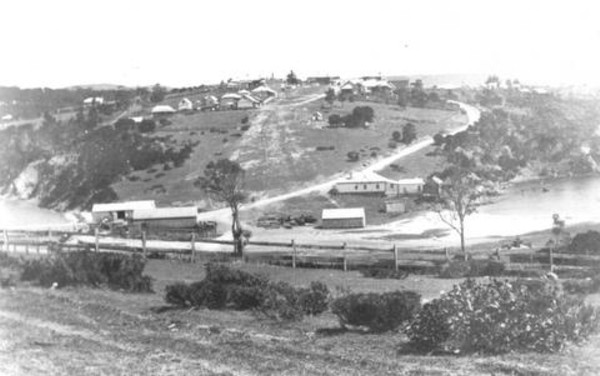
The Pier Hotel is to the right of the road winding up the hill from the harbour.
In any case it would not have been an easy matter for James and Kate. Kate was four months’ pregnant and had six young children aged 2 to 12 to care for. No doubt, however, the women of the town would have rallied to her assistance.
As noted in the reports in the Daily Telegraph the body of Flora McKillop would have been at the hotel from the evening of 3 June until its removal by Mrs McKillop’s nephew on 7 June.
The following is the letter written by Elly Keon on behalf of Kate Power to Mother Mary:
|
June 11th 1886 |
Altho’ not having the pleasure of your acquaintance, we all sympathised much with you and yours in your recent sad affliction. Tho’ there is a melancholy comfort (in) finding your loved mother’s remains, still it must be a source of peace and consolation to you all.
Mrs Power has just been here to show us your kind letter to her and begged of us to write to you stating that Mr Flannigan had nothing whatever to do with regard to your dear mother’s remains. Mr Flannigan (not Kennedy) arrived by same steamer as your nephew going back to his Master, a Mr Harrison, to whom he is cook (entre nous); no person here knows who he is or anything about him.
Mrs Power and Mrs Strandridge (nurse tending) (Mrs Emma Strangwidge was the Eden midwife. Her son William later married Mary Ann Power, the daughter of Red Johnny and Ann Power) are the two who rendered all services to your loved mother’s remains before even they knew who she was or if ever she might have been recognized.
Mrs Strandridge, nurse tender when Constable Davis (not Woods) went on the boat to fetch the remains, accompanied him.
After the dear deceased had been cared (for), Mr and Mrs Power had the remains taken to their Hotel, where they placed it in their best room. Mrs Strandridge procured all the nice flowers she could get, and both she and the Powers paid every respect due to the remains of your good and holy mother.
Mrs Power particularly wished to mention that she saw Flannigan’s name coupled with hers in the ‘Daily Telegraph’, as being the principal man looking after your dear mother’s remains. She desires this contradicted as it was her husband, James Power. From what we hear, this Flannigan made himself (a) very prominent personage before your cousin.
Kind regards to your cousin, Mr McDonald, whom we had the pleasure of seeing for a little while.
You will kindly excuse all the explanation, but these good women, Mrs Power and Mrs Strandridge, begged of us to write.
Any particulars you wish to know regarding your dear mother, Mrs Power and Mrs Strandridge may be able to tell you.
(Copyright C The Generalate, Sisters of St. Joseph of the Sacred Heart)
As you can see, Kate and Emma really got themselves worked up over Mr Flannigan! I must point out here that although not mentioned in the above letter there is a strong family tradition that Ann Power was also involved in caring for the remains of Mrs McKillop.
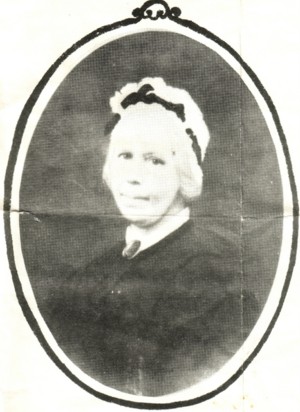

After the family left the Pier Hotel they lived in a big house that had formerly been the Exchange Hotel in Chandros Street, Eden and which is now the site of the Uniting Church hall. The previous occupants of this house had been Red Johnny and Ann Power and their family, and the house became available when they moved to a farm at Greigs Flat near Pambula.
When James and Kate’s only daughter Agnes married George Thomas Allen on 26 October 1898 the reception was held at the house and Bill Greig who lived opposite the Powers (and who, incidentally, was the last of the Eden shore whalers), told me in 1979 that the “Power boys got pretty drunk that day”.
Bill remembered Jim Power as a very quiet man. He was only home for weekends as he worked for years at the Pipeclay mines at Pambula. Bill recalled that Jim was short but broad and with a red beard.
Mary Ann Strangwidge confirmed that Jim was a quiet man: “All of the Power men were quiet.”
It must not have been very long after the wedding that James and Kate packed up to leave Eden. James had obtained a position as the operator of a quartz crushing battery at Dellicknora in Victoria, not far over the border from the southern New South Wales town of Delegate. Mary Anne Strangwidge told me that they went to a mine she thought was called the Bonanza, south of Delegate. The two youngest members of the family, Len and Vince, went with them but I am not sure about the movements of the other brothers except that, according to Bill Grieg, Hubert continued to work about Eden for several years after the family left. For James it was a return to the cold high country of his youth and I have a photograph showing James with Len and Vincent shovelling snow away from the door of their home at Dellicknora.
As I shall relate in more detail later, Agnes also joined the family at Dellicknora.
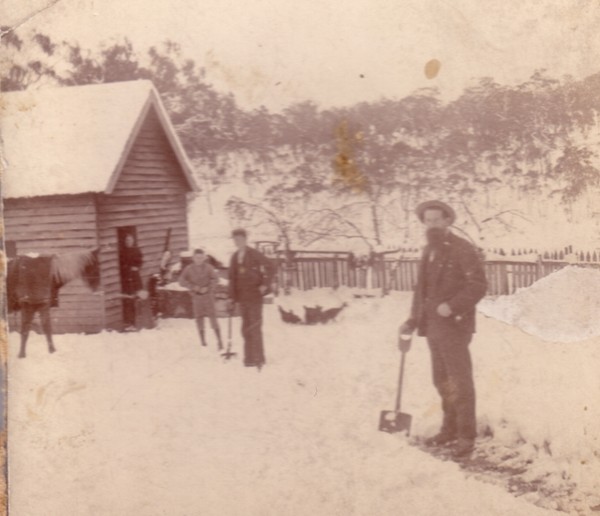
James Power
with sons Len and Vince shovelling snow at Dellicknora. Kate is standing in the
doorway with my father, one year old Joe Power. Thus this photo was taken in
1901.
After some years in Victoria the prospect of work for miners in Broken Hill saw the family on the move back to New South Wales - and this time to a place where they would certainly never see snow again!
In Broken Hill they lived in Chappel Lane and were eventually joined there by all of their other sons except the eldest, John Henry (Harry).
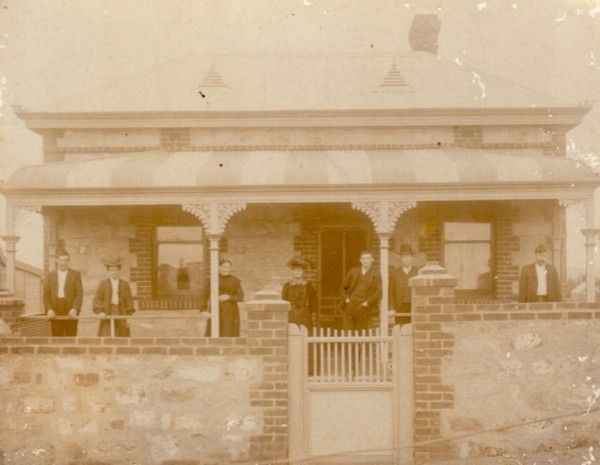
The Power
family at Chappel Lane, Broken Hill. From left: Frank Power, Anne Ferguson (a
friend), Kate Power, Mary Mocettini, Vince Power, Len Power, Tom Power
James did not live for many years after going to Broken Hill. The toll on his health of the years of mining - especially his time in the notorious Yowaka mine at Pambula that cut short the lives of so many of the Power men - saw him die on 9 September 1912, a month before his 66th birthday. In James’s final years the family had moved to Cobalt Street and Len gave that address when he registered his father’s death.
The details supplied by Len indicate, I believe, a final note of pride on James’s part. He is recorded under the heading of Occupation as “Miner (Gold)” and one can imagine James telling Len that that was how he wished to be remembered. He was no ordinary miner - he had mined for the most precious metal of all - gold!
Kate did not stay in Broken Hill for very long after her husband’s death. She went to live with Agnes who by then was raising a second family in Victoria.
After James’s death Kate had memorial cards prepared as well as a colourised photographic portrait of James in his later years. She gave the following directions to the colourist: Hair - dark brown; Eyes - blue; Complexion - good; Beard - Red.
Kate lived with Agnes for many years and suffered much from arthritis in her old age. She died in Melbourne on 18 April 1925 at the age of 76 and was buried at Fawkner Cemetery.
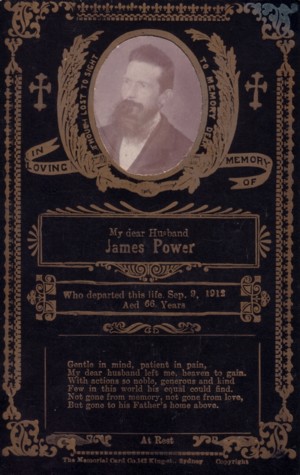

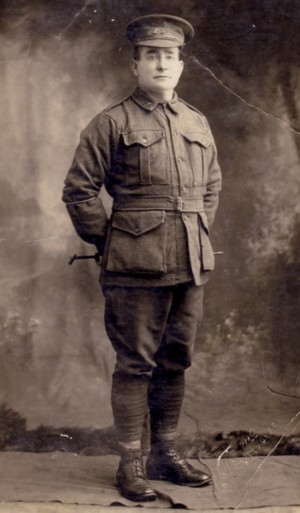
John Power, 1st Tunnelling Company
Harry was named after Red Johnny Power (who had taken Henry as a name in Confirmation). Certainly there were more than enough Johns about in the extended family already without another of that name to add to the confusion, so it is likely that he received the name of Harry from an early age.
It is likely that James and Kate went to live at Eden at about the same time that Red Johnny and Ann made the move there from Kiah and probably chiefly for the same reason: to allow their children to attend school and thereby gain the advantage of the basic education that they themselves so much regretted never having received.
Harry was the same age as Mary Ann Power and so they probably started together under the stern supervision of Mr Wellings. This, of course, was at the Eden Public School. In gratitude for the care bestowed on her mother at the time of the wreck of the Ly-ee-Moon, Mother Mary McKillop established a convent and school at Eden but that did not occur until 1891. By then Harry and the other older members of the family would have completed their schooling years. The youngest boys: Frank, Len and Vincent may have attended the convent school. I shall research that matter.
No doubt after leaving school Harry would have found work where he could around the area and probably joined his father in labouring jobs and, later, in mine work at the Yowaka Mine.
His army enlistment papers record his occupation as butcher but also showed that he had never been an apprentice.
I do not know whether he went to Dellicknora and then to Broken Hill with the family. However, there is a family story that he travelled right across the continent to become a publican in Australia’s hottest town, Marble Bar in Western Australia. The story says he was involved in some confrontation with the local aborigines and was speared by one of them. He was taken to hospital in Perth and while there read newspaper reports about the two young Belgian women who had been brought to Australia in an attempt to bolster the flagging enlistment numbers. These two women, it was alleged, had had their hands cut off by German soldiers and the display of this atrocity was intended to inflame the fervour of young Australians to go off to fight the Huns. In Harry’s case, according to the story, the propaganda worked. Although he was no youngster - he was 42 - Harry was readily accepted into an Army desperate for replacements for the increasing numbers of dead and wounded soldiers on the Western Front.
Details on Harry’s enlistment papers throw some doubt on the preceding story. He enlisted at Geraldton, not Perth, and he gave his place of residence as Carnarvon, not Marble Bar.
Harry enlisted on 12 April 1916. He was described as being 5 feet 6 inches tall, with a florid complexion, blue eyes and brownish red hair. He named his mother Kathrine Power as his next of kin and gave her address as Broken Hill. This was later crossed out and changed to “Osborne”, Gregory Street, Brunswick and later again to 55 Cecil Street, West Brunswick, Victoria.
The army obviously had more need for Harry’s mining skills rather than his experience as a butcher, for a month later he was attached to the Miners Corps Reinforcements and arrived in Seymour, Victoria on 18 July for further training. On 25 October he embarked on the Ulysses and, as with the Greek hero who gave his name to the ship, Harry’s journey was to be one into danger and ultimate death. Two months later - three days after Christmas Day - he disembarked at Plymouth and marched to the Australian Details Camp at Perham Downs. One month to the very day later he and his fellow miners went aboard the SS Onward at Folkestone for the short trip across the channel to France. Once there he was attached to the 1st Tunnelling Company, a unit that was to become famous for detonating the two biggest explosions in the history of warfare and ones that were not exceeded in immensity until towards the final stages of World War Two with the dropping of the atomic bomb on Hiroshima on 6 August 1945.
The men of the 1st Tunnelling Company were employed in a variety of tasks including the repairing of roads which were being constantly blasted by the German bombardment. However, their major role was the excavation of a network of tunnels below No Man’s Land extending out to beneath the enemy trenches. The plan then was to set charges below the enemy trenches and so destroy them and the German soldiers in them. Simultaneously the Germans were engaged in the same kind of operation and the tunnels of the opposing armies were often so close that the miners on both sides had to dig as quietly as possible to avoid being heard by the other side. While engaged in this hazardous work their own trenches were being regularly shelled and the following extracts from a report of Lieut Clinton to the C.O. of 1st Tunn Coy will give you an idea of the kind of horrors these miners faced.
“ On the afternoon of 25th April (1917) during an enemy bombardment, a minenwerfer or heavy shell pierced the Officers’ Dugout Quarters, exploding therein. Two officers were killed instantly and one died ...... on being lifted onto a stretcher. Five other officers were ....... gassed by Carbon Monoxide and Nitrous fumes.
At the opposite end of the system, and near the seat of the explosion, were the Batman’s Quarters, which were cut off, with the exception of one small hole just large enough to allow a Proto-man to go through. This section of the system was very heavily charged with carbon monoxodide and nitrous fumes, and caused the death of six batmen.
Corpl. Saxton evidently made another inspection of this portion of the system and was buried by a fall of earth at the exit. We soon had his head clear, and the mask of a Hovita Apparatus on his face. Corporal Saxton was breathing for a period of nearly two hours in this position, the mask not being removed but the cylinders being changed quickly on the apparatus. Time after time we got the earth off his head and shoulders, but another fall would bury him again. On some occasions he was completely buried for two minutes, but continued breathing all the time. There was only room for one man to work in the face at a time, and the average time a man worked did not exceed five minutes, on account of carbon monoxide filtering through the sand from the Batman’s Quarters. On the recovery of Corpl. Saxton’s body it was found that his feet had become entangled in some electric wires.
During the rescue operations from ten to twelve men working in this face were more or less affected by the poisonous gases.”
The tunnels and the large underground chambers to accommodate the explosives were finally completed and then came the even more dangerous task of dragging the huge amounts of high explosives to the detonation sites.
By 7 June all was in readiness and at zero hour (3.10 am) the detonations commenced. As detailed in the Company’s War Diary, “A” charge consisting of 45,700 pounds of ammonal and 7,800 pounds of G.C., buried at a depth of 90 feet, was exploded leaving a crater 33 feet deep and 191 feet wide - about the size of the playing area at the Melbourne Cricket Ground. “B” Charge was even bigger - 70,000 pounds of ammonal - and located at a depth of 100 feet. It blew away a huge mass of earth producing a crater 51 feet deep and 260 feet across. There was no way of knowing with any accuracy what the death toll among the German soldiers asleep in their dugouts was, but it has been estimated that several hundreds died.
Harry seems to have survived the war without any serious wounds but must have had some narrow escapes and witnessed some terrible sights. He told my father how once he was in his trench during a quiet period when suddenly a German shell landed very close by and exploded. One of his mates who happened to be above ground at the time was completely blown to pieces - he literally disappeared.
Harry was sent to hospital on four occasions with scabies, influenza, eye problems and gastro enteritis. Once while on leave in England he also spent some time in hospital. Harry told my father that he had been gassed although this was not indicated in his record. No doubt, as Lieut. Clinton’s report above indicates, most of the men at the front would from time to time have been “more or less affected by the poisonous gasses” and the cumulative effects of a number of exposures would have had an increasingly adverse effect on the person’s respiratory system.
In the following letter written to my father three months before the end of the war Harry seems well and optimistic:
|
Aug 9th 1918 |
How is Mother getting on. I suppose it is a trouble for her to get about at all. I have not heard from any of the boys. I wrote to Len about 12 months ago and also about 6 months ago but I don’t suppose he has received them. Well Joe there is nothing to tell you from here. You will see by the papers before you get this letter about the great Push on Aug 8th.
The “great Push on Aug 8th” was the inappropriately named Battle of Amiens (it was actually fought east of Villers-Bretonneux, many miles from Amiens). It was the first occasion during this terrible war that the five A.I.F. divisions had fought side-by-side. Under the command of General John Monash and with the Canadian Corps on their right flank the Australians attacked brilliantly to burst through the German lines and so finally break the long stalemate of trench warfare. The detailed story of this great victory can be read in Volume VI of The Official History of Australia in the War of 1914-18 by Dr Charles Bean.
Following the armistice Harry was soon back in England and on 15 January 1919 he went aboard the City of Exeter for the long-awaited voyage home to Australia.
When Harry was discharged in Melbourne on 7 May 1919 he was classified as unfit and he was to be in and out of hospital for the rest of his days. In 1921 he received the British War Medal and in 1922 the Victory Medal. He died in the Caulfield Repatriation Hospital on the day after Anzac Day in 1931 and was buried at Fawkner Cemetery in his mother’s grave.
I know very little of Tom except that he worked as a butcher in Darwin for some time before returning to Broken Hill. Perhaps he and Harry had worked together in a meat works there before splitting up, with Harry making the fateful decision to travel down the west coast. Tom avoided the temptation to enlist but was unable to escape the second great calamity that struck the world before the 1920s. He became infected during the 1919 influenza pandemic and died in Broken Hill at the age of 44.
When she was thirteen Agnes was bridesmaid at the marriage of her cousin and good friend, Mary Ann Power to Harry Strangwidge.
A few years later Agnes met a miner named George Thomas Allen from the Pipeclay mine and considered him to be “the catch of the town”. Allen was working at the Yowaka mine in the Pipeclay area near Pambula and would have got to know the Power men, including James, who were also employed there. Through them he came to meet Agnes. The one photograph we have of Tom Allen shows him to be a much older and more sophisticated person than 20 year old Agnes. Mary Anne Strangwidge wrote in a letter to me on 10 September1967: “I would say he was (30) thirty years, he was no teenager”.
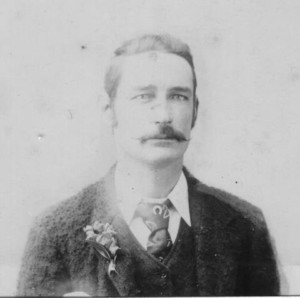
George Thomas
Allen who married Agnes bigamously.
Agnes and Tom Allen were married with a Nuptual Mass by Father Richard Condon at the Eden Catholic Church on 26 October 1898. Agnes’s uncle, Red Johnny Power, and Helena Hopkins were the witnesses. On the marriage certificate Allen declared himself to be a bachelor. He further stated that he had been born at Bullorouk Forest in Victoria and was the son of James Allen and Kate Plant. None of these assertions appear to have been true. I have checked the Victorian births, deaths and marriages records and have not been able to detect any connection of people with these names living as a family in the Bullorouk Forest area.
I am not sure where Tom and Agnes lived after their wedding but 18 months later Agnes was with her mother at Dellicknora for the birth of her first child, James Joseph, on 18 April 1900.
It wasn’t very long after this that a rumour reached Agnes that her husband was already married at the time of their wedding. According to Agnes’s daughter, Vera Hamann (nee Bateman), when Agnes confronted Allen with this story he said nothing; he simply mounted his horse and rode away. She never saw him again.
In a letter to me on 23 March 1967 Mary Anne Strangwidge wrote: “I would think Tom Allen would be 30 at the time of his marriage to Agnes. He was already married, his wife living in Nevertire with 3 children”.
In an interview I had with Bill Grieg on 14 January 1980 he stated: “Allen met Jim Power at the mines there near Griegs Flat. A saddler named Ted Brown knew that Allen had been married before but did not speak up”.
Agnes was devastated by this revelation and her desertion by the man she had married in good faith, and shut herself away in her room. The young teacher at the small state school in Dellicknora, Arthur Bateman, was friendly with the Powers and he convinced Agnes that she had nothing to be ashamed of and should not become a recluse. Eventually their friendship blossomed into romance and they decided to marry.
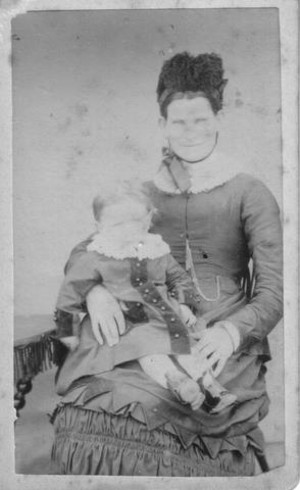
Kate Power nursing her grandson, Joe Power. Photo taken in 1901.
There must have been much discussion about the custody, care and upbringing of Agnes’s baby Joe and it appears that Bateman was not willing to accept the role of step father with all of its attendant responsibilities. His attitude may have been partly due to the coolness of his parents towards the marriage. They did not attend the wedding and when Arthur and Agnes called on them during their honeymoon, Arthur’s mother would not let them into the house until she had seen their marriage certificate.
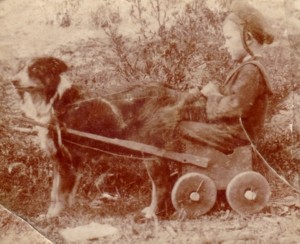
Joe Power in a dog cart at the home of his aunt, Jane Stokes, at Delegate
in about 1904.
James and Kate took over Joe’s upbringing and as he grew up he always considered them to be his parents and their sons to be his brothers rather than uncles. Over the years too he often travelled to spend holidays with Agnes but always looked upon these times as visits to his sister.
Joe went with the family to Broken Hill and attended the convent school there during his primary school years. He managed to get a job as a lolly boy at the cinema and recalled that he was at the cinema on New Year’s Day 1915 when the news came through of the infamous incident when Afghans fired on the picnic train on its way to Silverton.
At the cinemas in those days there were vaudeville acts as well as films and Joe assisted a comedian named Leonard Nelson with his props. A popular part of his act was playing the role of a drunk while singing “Mr Booze”. In later years my father could always be enticed at parties to sing a comic song called “The Old Cock Fowl” and his performance was always rewarded with great applause. He possibly learnt that song at the Broken Hill cinema.
He told me of how he annoyed Kate one day by mimicking over and over her daily washing instructions to him: “Head, neck and ears”. She became angry and hit him on the head with a dipper which set him running around the house screaming, “Help! Police! Murder!”
Kate apparently had very few teeth left as she grew older and Joe once suggested to her that she buy false teeth. Her reply was: “I wouldn’t have dead people’s teeth in my mouth.”
Joe proved to be a bright pupil and James and Kate, with the assistance of their sons, put enough money together to have him sent as a boarder to Christian Brothers College in Adelaide for his secondary education. His uncles (whom he believed were his brothers) were determined that he should not become a miner and that a good secondary education would enable him to make a better life for himself.
By the time that he completed Form 4 his widowed “mother” Kate had moved to Melbourne to live with Agnes and he joined them there in Brunswick.
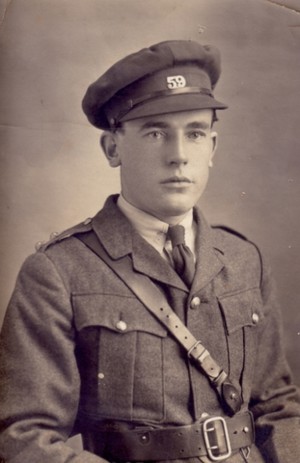
Lieutenant Joe Power in 1917
When he was 17 he decided to join the Citizens Forces (Army Reserve) and wrote off for his birth certificate. Joe was puzzled when he received a letter to say that there was no record of the birth of a James Joseph Power and asked Kate how this could be. Agnes sat him down and told him the story of his father and how Kate and James had raised him and that she was not his sister but his mother. Vera said, “Well, Joe kicked up a stink and said that Mum (Agnes) wasn’t a fit and proper person to be a mother.” Eventually he calmed down and accepted the situation but decided to retain the Power name.
Joe obtained a position with the British Phosphate Company in Melbourne and they assisted him in his studies in chemistry at the Melbourne Working Men’s College (later to become R.M.I.T. University where one of his grandsons, John Power, is now [2010] a lecturer in the Department of Animation and Multi Media).
Joe met a Brunswick girl named Tasma Meeking and later married her on Christmas Day 1926. Five years later they settled at North Shore an outer suburb of Geelong. I shall tell Tas and Joe’s story in a history of the Meeking family that I am currently working on.
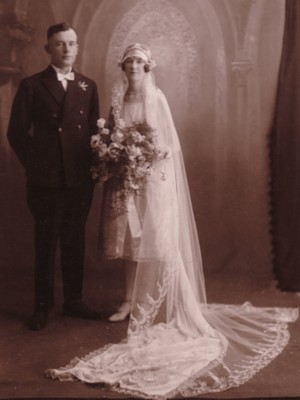
Joe Power and Tasma Meeking on their wedding day, Christmas Day 1926.
Agnes and Arthur Bateman had been married at St John’s Church Of England, Bairnsdale on Christmas Eve 1901 when Joe was still a baby of 20 months. Agnes declared herself to be a spinster so obviously there was no doubt in her mind that she had never been legally married to Allen.
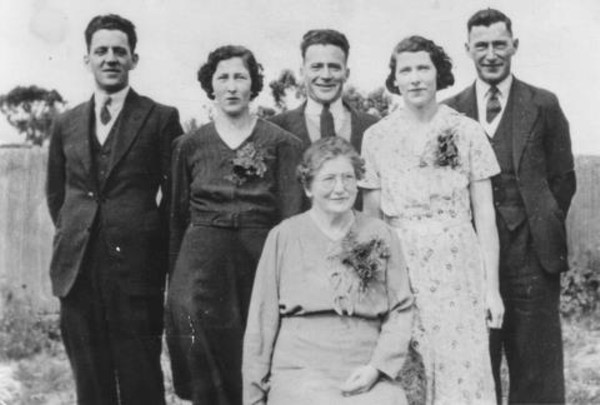
Agnes Bateman
(seated) with Jimmie, Vera, Frank, Ethel Louise (“Dolly”) and Wilf.
As a school teacher Bateman was sent to various postings around the state so apart from the school holiday time it was impossible for Agnes to maintain regular contact with Joe and her parents.
Agnes and Arthur Bateman had six children:
Name D.O.B. Birth Reg Place Reg No
1. Francis James Bateman 1903 Orbost 20345
2. Wilfred Power Bateman 1905 Korong Vale 19318
3. Vera Annie Bateman 1906 Bendigo 24279
4. Arthur Thomas Bateman 1907 Serpentine 30198
5. Ethel Louise Bateman 1909 Mysia 29617
6. Bertram Vincent Bateman 1911 Mysia 5580
On 27 and 28 January 1978 I recorded interviews with Agnes and Arthur’s older daughter, Vera, and most of the information that follows will be based on those interviews, with any direct quotations being Vera’s actual words.
Frank was born at Dellicknora so it is probable that Arthur was still teaching there up until that time.
By the time of the birth of their second child, Wilf, Arthur had been appointed to Korong Vale, a school north-west of Bendigo. Over the following years he was to teach in a number of schools in that area: Serpentine, Bears Lagoon, Baringhup, Mysia and Maldon.
Vera recalled Agnes’s stories of living at Condah Swamp south of Hamilton: “I was about six months when we lived at Condah Swamp. It was full of tiger snakes and one night the cat was going mad and Dad said ‘there’s a snake out there’ and said to Mum ‘hold the candle while I kill it’. Mum’s duly holding the candle and Dad’s hitting the snake. The snake hissed and Mum dropped the candle and left Dad in the dark with the snake. You couldn’t go to bed there at night; you had to strip the bed before getting in.”
Arthur had suffered from rheumatic fever during their honeymoon and from then on never seemed to enjoy really good health.
Vera was born at Bendigo Hospital. Her father was ill in the same hospital at the time and Agnes must have been anxiously awaiting Vera because Vera claimed her mother told her this story: “Mum took a box of Beecham’s Pills and shifted me out and I’ve been running ever since.”
Arthur was a good teacher, firm but not severe with the children. His own four eldest children attended schools that he taught at. Vera started school at Mysia.
Arthur would ring the school bell to summon them for tea. He only rang it once. Vera recalled that they had to all sit up at the table and speak nicely. If someone misbehaved “Dad would raise his eyebrow and that would be enough”. One of Vera’s earliest memories is of sitting on her father’s knee and looking at his moustache. He said to her, “I’ll let my beard grow right down to there,” tapping his other knee.
“When Dad was very ill he gave up teaching and they bought the combined hotel/post office/general store at Baringhup (west of Maldon) known as the Loddon Hotel.”
Arthur died there in June 1912, a month after his 40th birthday. Vera remembered coming home from school and seeing her father laid out in his coffin in her parents’ bedroom with her mother sitting on the bed. He was buried in the Maldon Cemetery.
With her husband’s death Agnes was left with six young children to raise with Frank the oldest at only nine years of age. Agnes decided to sell the hotel and move down to Melbourne, first to Blackburn, then to Box Hill and finally to Brunswick.
Dolly (Ethel Louise) commenced school at Box Hill.
Three months after the death of her husband, Agnes suffered the loss of her father, James, who died in Broken Hill on 9 September 1912. Some time later Kate came down to Melbourne to live with her only daughter and continued to do so until her death on 18 April 1925.
Vera remembered members of the family coming from Broken Hill to visit them. She also recalls her mother sending a pound note to one of the family in Broken Hill when the mines were closed because of a strike.
Agnes came down with cancer when she was in her late sixties and died at Brunswick in 1946.
She’d had a hard, sad life.
2.jpg)
Agnes In her
old age
These are the details of the children of her marriage with Arthur Bateman.
1. Frank Bateman married Wilma Martin. Their four children are
1. Ted Bateman
2. Shirley Bateman
3. Betty Bateman and
4. Wilma Bateman
2. Wilf Bateman married Lucy Clark. They had two children,
1. Patricia Bateman and
2. Arthur Bateman.
3. Vera Bateman married Charles Hamann and they too had a boy and a girl:
1. June Hamann and
2. Charlie Hamann.
4. Arthur Bateman died at the age of 10.
5. Ethel Bateman married Leo McNamara and their three daughters are
Nora, Carmel and Maureen
1. Maureen McNamara,
2. Nora McNamara and
3. Carmel McNamara
6. Bertram Vincent (“Jimmie”) Bateman married Marj Cronin. They had no children.
Agnes had another child, Leslie Raymond Bateman, born in 1915. Leslie married Sylvia Gaskett and their six children were:
1. Robert Bateman
2. Barry Bateman
3. Marlene Bateman
4. Barbara Bateman
5. Leslie Bateman and
6. Ronald Bateman
Leslie died in 1970 and Sylvia in 1988.
The Younger Power Brothers
I know little of the lives of Ade, Hube, Frank, Len and Vince but I shall give the few details I have recorded.
4. James Adrian (“Ade”) Power (1880-1950)
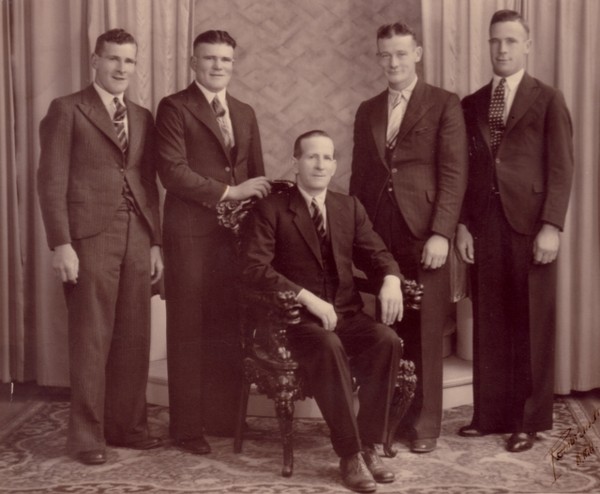
Ade Power with his four sons Frank, Vince, Jim & Ted
Norah Power
Ade married Honorah Catherine (“Norah”) Fitzgerald in the Cathedral at Broken Hill.
They had six children: Jim, Ted, Frank, Nora, Mary and Vincent.
1. James Power married Kath Hall and they had one son, Robert Power, who now lives in Adelaide. James died during WW2.
2. Edmund Arthur (“Ted”) Power married Bess White. Their children are Ted Power, Patsy Power and Vincent Power, all of whom live in Queensland.
3. Francis Thomas Power and his wife are both deceased.
4. Honora (“Nonie”) Power married Ronald Gepp. They have five children. They live in Broken Hill.
5. Mary Margaret Power is married to M O’Brien with three children. They too live in Broken Hill.
6. Henry Vincent Power lives in the Home of Compassion in Broken Hill. His wife and only daughter are deceased.
Ade died on 22 January 1950. Norah died five months later on 23 June 1950. They are both buried at Broken Hill.
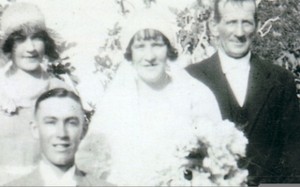
Nonie Power and
Ron Gepp on their wedding day.
5. Hubert Power (1882-1929)
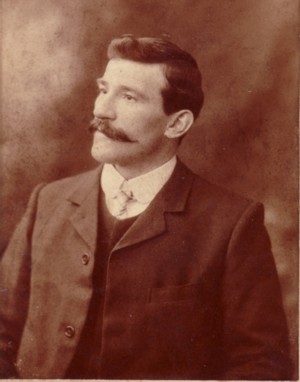
Hubert Power
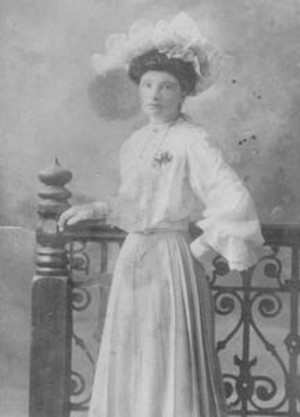
Mary
Mocettini,
aged 21
Hube married Mary Lucy Mocettini in Broken Hill. Their family consisted of three boys and three girls: Florrie (born 1907), Kathleen (1910), Mick (1914), Jack (1917), Eileen (1921) and Tom (1923).
1. Mary Florence (“Florrie”) Power married Harry Bertram.
1. William Hubert Bertram, the older of their two children, never married and died in 1980 at the age of 48. Their second child,
2. Lorraine Joyce Bertram, married Leo William Schmidt in 1956. Their three children are Neville Schmidt, Gavin Schmidt and Narelle Schmidt.
Florrie died in Broken Hill in 2008 at the age of 100.
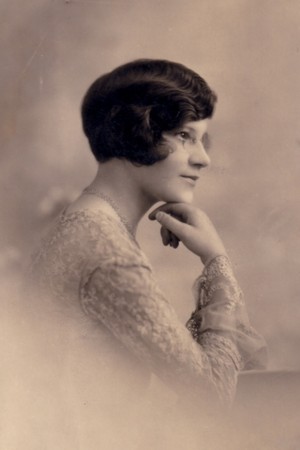
A
young Florrie Power
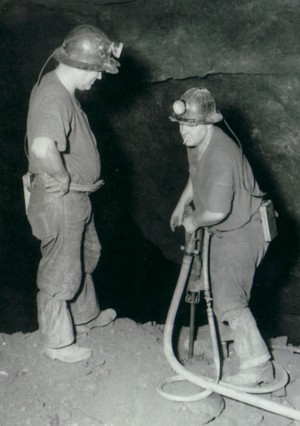
Florrie’s
husband, Harry Bertram, and Jack Hall working in the North Mine, Broken Hill
2. Kathleen May Power married Joseph Patrick McMahon in May 1943. They did not have children and now live in Whyalla, South Australia.
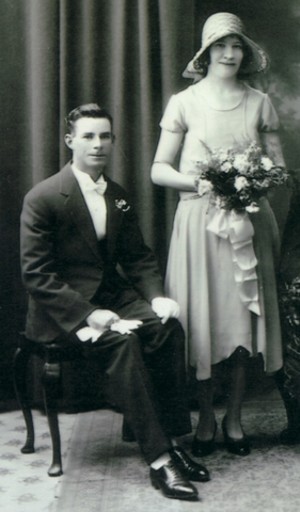
Kathleen
Power and Joe McMahon.
3. Hubert Louis Vincent (“Mick”) Power married Florence Mary Hywood and they had three children: Mary Ellen Power, John Hubert Power and Rita May Power. Hubert died in 1982 aged 68.
4. John Phillip (“Jack”) Power died in Mildura in 1934 at the age of 17.
5. Eileen Mavis Power married Frederick Arthur Borchard in 1941. Their twin adopted sons are Keith Borchard and Barry Borchard.
6. Thomas Henry Power did not marry. He died aged 34 in Broken Hill in 1957
Hubert (senior) died in Broken Hill in 1929 at the early age of 46. Mary died in 1956 aged 70 years.
6. Francis Nicholas Power (1884-1943)
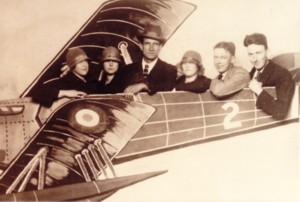
Frank Power is
third from the left.
Frank did not marry until late in life. He was more than 50 when he married Annie May Geoghegan in 1935. Annie had been born in Bunbury, West Australia in 1880, the daughter of Samuel Fisher and Rebecca McAffery. Thus she was either a widow or a divorcee when she married Frank. Sadly she died in the year following their wedding.
7. Leonard Vincent Power (1886-1966)
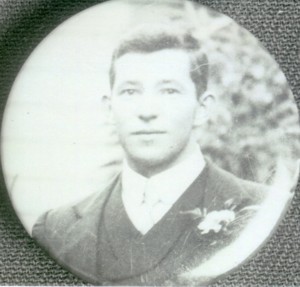
A young Len
Power
A young Mary
Murray
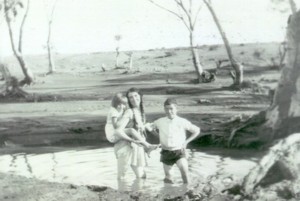
Len and Mary’s three children, Thora, Maureen and Ronald enjoy a rare
waterhole near Broken Hill.
Len married Mary Jane Murray in Broken Hill in 1914. Their three children are Thora, Ron and Maureen.
1. Thora Aileen Power married Philip Gosschalk at Broken Hill in 1941. Their two children are
1. Leonie Georgina Gosschalk and
2. Warwick Jeffery Gosschalk.
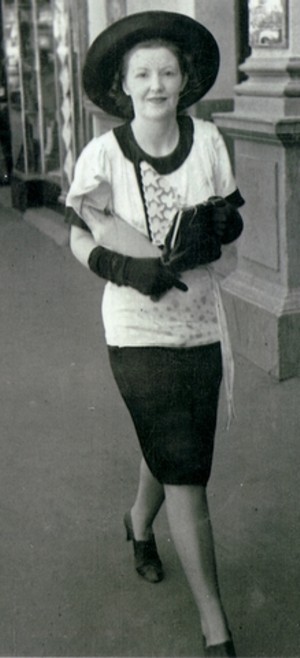
Thora Power (Mrs Gosschalk).
2.
Ronald Murray Power
married Edna
Agnes Armour in Sydney in 1944.
Their children are
1. Dianne Lynette Power and
2. Murray Armour Power.
3. Maureen Joyce Power married Francis Arthur Reynolds in Sydney in 1953. Their only child is Karen Michele Reynolds. Maureen died in Broken Hill on 18 November 2008 aged 85.
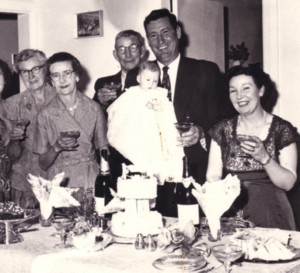
Karen Reynolds’ Christening. From left: Mary Power, Bertha Gorman (Len’s
cousin), Len Power, Karen Reynolds, Frank Reynolds and Maureen Reynolds.
Len died in 1966 and Mary in 1979.
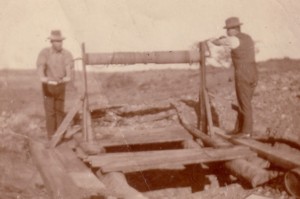
Len and Hubert Power at work at their mine site near Broken Hill.
8. Stephen Vincent (“Vince”) Power (1888-1908) contracted influenza when he was a young man and died in Broken Hill in about 1907.
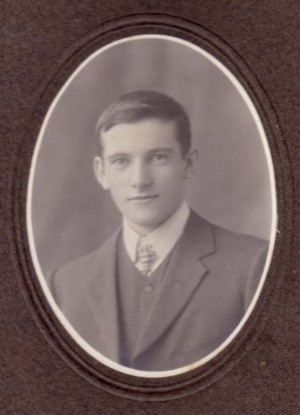
Vince Power
|